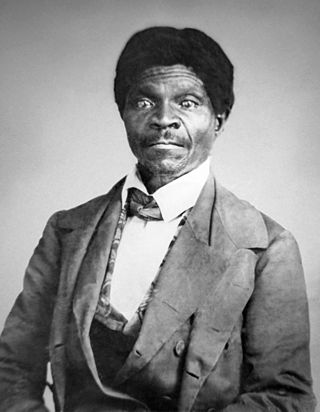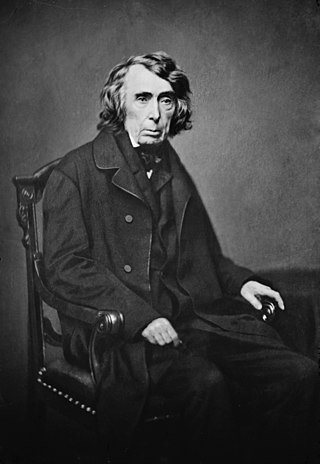Dred Scott v. Sandford, 60 U.S. 393 (1857), was a landmark decision of the United States Supreme Court that held the U.S. Constitution did not extend American citizenship to people of black African descent, and thus they could not enjoy the rights and privileges the Constitution conferred upon American citizens. The decision is widely considered the worst in the Supreme Court's history, being widely denounced for its overt racism, perceived judicial activism, poor legal reasoning, and crucial role in the start of the American Civil War four years later. Legal scholar Bernard Schwartz said that it "stands first in any list of the worst Supreme Court decisions". Chief Justice Charles Evans Hughes called it the Court's "greatest self-inflicted wound".

Dred Scott was an enslaved African American man who, along with his wife, Harriet, unsuccessfully sued for freedom for themselves and their two daughters, Eliza and Lizzie, in the Dred Scott v. Sandford case of 1857, popularly known as the "Dred Scott decision". The Scotts claimed that they should be granted their freedom because Dred had lived in Illinois and the Wisconsin Territory for four years, where slavery was illegal, and laws in those jurisdictions said that slaveholders gave up their rights to slaves if they stayed for an extended period.

North Carolina v. Mann, 13 N.C. 263, is a decision in which the Supreme Court of North Carolina ruled that slave owners had absolute authority over their slaves and could not be found guilty of committing violence against them.
A number of cases were tried before the Supreme Court of the United States during the period of the American Civil War. These cases focused on wartime civil liberties, and the ability of the various branches of the government to alter them. The following cases were among the most significant.
Rachel v. Walker (1834) was a "freedom suit" filed in the St. Louis Circuit Court by an African-American woman named Rachel who had been enslaved. She petitioned for her freedom and that of her son James (John) Henry from William Walker, based on having been held illegally as a slave in the free territory of Michigan by a previous master, an Army officer. Her case was appealed to the Supreme Court of Missouri, where she won in 1836. The court ruled that an Army officer forfeited his slave if he took the person to territory where slavery is prohibited. This ruling was cited as precedent in 1856 in the famous Dred Scott v. Sandford case before the Supreme Court of the United States.
Prigg v. Pennsylvania, 41 U.S. 539 (1842), was a United States Supreme Court case in which the court held that the Fugitive Slave Act of 1793 precluded a Pennsylvania state law that prohibited blacks from being taken out of the free state of Pennsylvania into slavery. The Court overturned the conviction of slavecatcher Edward Prigg as a result.

The Supreme Court of Missouri is the highest court in the state of Missouri. It was established in 1820 and is located at 207 West High Street in Jefferson City, Missouri. Missouri voters have approved changes in the state's constitution to give the Supreme Court exclusive jurisdiction – the sole legal power to hear – over five types of cases on appeal. Pursuant to Article V, Section 3 of the Missouri Constitution, these cases involve:

The Taney Court refers to the Supreme Court of the United States from 1836 to 1864, when Roger Taney served as the fifth Chief Justice of the United States. Taney succeeded John Marshall as Chief Justice after Marshall's death in 1835. Taney served as Chief Justice until his death in 1864, at which point Salmon P. Chase took office. Taney had been an important member of Andrew Jackson's administration, an advocate of Jacksonian democracy, and had played a major role in the Bank War, during which Taney wrote a memo questioning the Supreme Court's power of judicial review. However, the Taney Court did not strongly break from the decisions and precedents of the Marshall Court, as it continued to uphold a strong federal government with an independent judiciary. Most of the Taney Court's holdings are overshadowed by the decision in Dred Scott v. Sandford, in which the court ruled that African-Americans could not be citizens. However, the Taney Court's decisions regarding economic issues and separation of powers set important precedents, and the Taney Court has been lauded for its ability to adapt regulatory law to a country undergoing remarkable technological and economic progress.

Robert Cooper Grier was an American jurist who served on the Supreme Court of the United States.

John McLean was an American jurist and politician who served in the United States Congress, as U.S. Postmaster General, and as a justice of the Ohio and U.S. Supreme Courts. He was often discussed for the Whig Party nominations for president, and is also one of the few people who served in all three branches of government.

Samuel Nelson was an American attorney and appointed as judge of New York State courts. He was appointed as a Justice of the Supreme Court of the United States, serving from 1845 to 1872. He concurred on the 1857 Dred Scott decision, although for reasons different from Chief Justice Taney's.

George Mathews Jr., was a Judge of the Superior Courts of the Territory of Mississippi and the Territory of Orleans, and Presiding Judge of the Louisiana Supreme Court from 1813 until his death in 1836. His ruling in Marie Louise v. Marot was cited as precedent by dissenting U.S. Supreme Court Justice John McLean in the 1856 landmark Dred Scott v. Sandford case.

Lemmon v. New York, or Lemmon v. The People (1860), popularly known as the Lemmon Slave Case, was a freedom suit initiated in 1852 by a petition for a writ of habeas corpus. The petition was granted by the Superior Court in New York City, a decision upheld by the New York Court of Appeals, New York's highest court, in 1860 on the eve of the Civil War.

Marguerite Scypion, also known in court files as Marguerite, was an African-Natchez woman, born into slavery in St. Louis, then located in French Upper Louisiana. She was held first by Joseph Tayon and later by Jean Pierre Chouteau, one of the most powerful men in the city.

Freedom suits were lawsuits in the Thirteen Colonies and the United States filed by slaves against slaveholders to assert claims to freedom, often based on descent from a free maternal ancestor, or time held as a resident in a free state or territory.
Jones v. Van Zandt, 46 U.S. 215 (1847), was a landmark US Supreme Court decision involving the constitutionality of slavery that was a predecessor of Dred Scott v. Sandford. The Supreme Court was then led by Chief Justice Roger Taney, who owned slaves and wrote the Dred Scott decision but not Jones. The Court unanimously reached the decision that the Fugitive Slave Act of 1793 was constitutional and that the institution of slavery remained a matter for individual states to decide.

Harriet Robinson Scott was an African American woman who fought for her freedom alongside her husband, Dred Scott, for eleven years. Their legal battle culminated in the infamous United States Supreme Court decision Dred Scott v. Sandford in 1857. On April 6, 1846, attorney Francis B. Murdoch had initiated Harriet v. Irene Emerson in the Circuit Court of St. Louis County, making the Scotts the first and only married couple to file separate freedom suits in tandem.

Robert Wash served on the Supreme Court of Missouri from September 1825 to May 1837. During his term, the pro-slavery judge, who owned slaves himself, wrote the dissenting opinion on several important freedom suits, including Milly v. Smith, Julia v. McKinney and Marguerite v. Chouteau. However, he did join in the unanimous finding for the plaintiff in the landmark Rachel v. Walker case.
Winny v. Whitesides alias Prewitt was the first freedom suit heard by the Supreme Court of Missouri. The case established the state's judicial criteria for an enslaved person's right to freedom. The court determined that if a slave owner took a slave into free territory and established residence there, the slave would be free. The slave remained free even if returned to slave territory, engendering the phrase "once free, always free."
The Guardian of Sally v. Beatty was a 1792 court case decided in the Supreme Court of South Carolina. A jury charged by Chief Justice John Rutledge held that a slave who had been bought and manumitted by another slave was free, not the other slave's owner's property.













